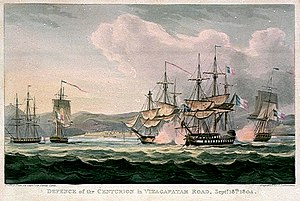HMS Centurion (1774)

Defence of the Centurion in Vizagapatam Road, Septr. 15th 1804, Engraving by Thomas Sutherland after a painting by Sir James Lind
|
|
| History | |
|---|---|
|
|
|
| Name: | HMS Centurion |
| Ordered: | 25 December 1770 |
| Builder: | Barnard & Turner, Harwich |
| Laid down: | May 1771 |
| Launched: | 22 May 1774 |
| Completed: | By 9 September 1775 |
| Fate: |
|
| General characteristics | |
| Class and type: | 50-gun Salisbury-class fourth rate |
| Tons burthen: | 1,044 11⁄94 (bm) |
| Length: |
|
| Beam: | 40 ft 5 in (12.3 m) |
| Depth of hold: | 17 ft 3 1⁄2 in (5.27 m) |
| Propulsion: | Sails |
| Sail plan: | Full rigged ship |
| Complement: | 350 |
| Armament: | |
HMS Centurion was a 50-gun Salisbury-class fourth rate of the Royal Navy. She served during the American War of Independence, and during the French Revolutionary and Napoleonic Wars.
During the war with America, Centurion saw action in a number of engagements and supported British forces in the Caribbean and the North American coasts. Spending the period of peace either serving as a flagship in the Caribbean or laid up or under refit in British dockyards, she was recommissioned in time to see action in the wars with France, particularly in the East Indies.
Her most important action came in the Battle of Vizagapatam in 1804, in which she fought against the French squadron of Contre-Admiral Charles-Alexandre Durand Linois that consisted of a 74-gun ship, and two frigates. Despite sustaining severe damage, she continued fighting, and survived the assault by the considerably heavier forces.
Returning to Britain shortly afterwards, she was refitted and transferred to Halifax, where she served as a hospital and receiving ship for the rest of her career. She sank at her moorings there in 1824, and was raised the following year and broken up, ending 50 years of Royal Navy service.
Centurion was ordered on 25 December 1770 and laid down in May 1771 at the yards of Barnard & Turner, of Harwich. She was launched on 22 May 1774 and had been completed by 9 September 1775. She cost a total of £20,537.17.9d, including masts and rigging, with a further £4,205.16.10d spent on fitting her out for sea.Centurion was commissioned in July 1775 under her first commander, Captain Richard Braithwaite.
Under Braithwaite, Centurion sailed to North America in late 1775, and was present at the occupation of Rhode Island in December of the following year.Centurion was part of Richard Howe's fleet at its encounter with the comte d'Estaing on 11 August 1778, after which she briefly became Howe's flagship between 14 and 15 August. By November, she was in the West Indies with William Hotham's forces, where she supported the landings on St. Lucia on 14 and 15 December. Remaining in the Leeward Islands throughout 1779, Centurion took part in the Battle of Martinique on 17 April 1780, followed by periods of action in the indecisive clashes that took place on 15 and 19 May. Centurion, then returned to Britain and was paid off in September 1780.
...
Wikipedia
